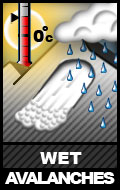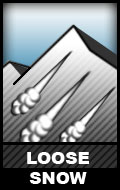Weekend Avalanche Outlook
Issued Friday, April 21, 2017 at 11am. This is a general backcountry (recreational) avalanche advisory for Chugach State Park with the Front Range and South Fork Eagle River areas as the core advisory zones.
Avalanche danger will increase through the day with rising temperatures and exposure to the sun, especially on steep solar aspects: easterly aspects first, followed by southerly aspects (the most problematic), and then westerly aspects. Avalanche danger will decrease through the night with falling temperatures and darkness. Aspect and timing will also determine surface conditions (icy crust, ripe corn, or isothermal slop).
This melt-freeze cycle will then repeat but, as this advisory will likely not be updated until next weekend, be especially mindful if conditions change next week: if temperatures do not fall below freezing overnight, avalanche danger will stay elevated overnight and avalanche conditions will be even more dangerous with rising temperatures the next day. The possibility of rain and/or new snow next week will also impact stability.
Here is a great guide for managing the spring avalanche conditions expected this weekend.
Signs of increasing danger due to warming include wet loose avalanches from steep solar aspects (which have the potential to trigger wet slabs as they descend), rollerballs, and increasing penetration at your feet as the snow becomes wetter. Even where these danger signs do not give warning, beware that warm temperatures can destabilize the snowpack and reawaken persistent slab instabilities.
Make sure you know how to identify avalanche terrain and dangerous avalanche paths that can threaten commonly traveled routes like summer trails (e.g. Crow Pass, Penguin Ridge, Falls Creek, Powerline, Flattop, O’Malley Gully, Twin Peaks). Warm temperatures may trigger natural avalanches in the upper elevations that can run into the lower elevations and cross terrain and trails that may be flat and even snow free (e.g. Falls Creek).
Practice safe travel protocols, carry necessary personal safety and rescue gear, and leave a trip plan (with emergency response) with someone that is staying in town.
Avalanche Problems:
Natural (especially initiating as point releases from rocky terrain) and human triggered wet loose avalanches up to D2.5 in size are likely in the afternoon and evening on steep, solar aspects at all elevations. These will be relatively slow moving, but heavy and high volume. They will have the potential to injure a person (due to their wet-concrete-like nature), cause a loss of control, or bury a person (especially if there’s a terrain trap).
Wet slab avalanches up to D3 in size may be triggered by natural wet loose avalanches, or a human trigger on a slope after it has become too wet. Many natural wet slabs, triggered by natural point releases or wet loose avalanches, have been observed on south to southwest aspects in the past couple weeks across Chugach State Park – in most cases ripping out the entire snowpack to the ground.
Be on the lookout for paths that could channel naturally triggered wet avalanches; don’t linger around such paths. Also, if traveling around steep rocky terrain (especially if channeled – like couloirs), watch for rockfall (and wear a helmet!).
Cornices, that have been growing throughout the season and are quite large in some areas, will be subjected to intense solar radiation and warm temperatures this weekend. This may cause them to fail naturally, or be especially susceptible to failing from the weight of a human.
Be especially cautious around cornices overhanging solar aspects and overhead cornice fall hazard; these could fail naturally and, besides posing an inherent hazard, they could trigger a dangerous (most likely wet loose and/or wet slab) avalanche as they fall onto and descend a slope.
As always, don’t approach a snowy ridge to look down slope unless you’re sure it’s not corniced. Give corniced ridges a wide berth; they can break back further than expected.
Isolated persistent slabs up to D3 in size are possible on steep (35*+) terrain above 3000′, primarily on upper elevation northerly aspects that have not undergone a melt-freeze cycle and where persistent weak layers (like the relatively widespread facet layer above firm wind slab from the month long dry spell, in some areas with surface hoar, and the widespread basal weak layer of advanced facets and depth hoar) may be preserved.
Persistent slabs could be triggered by warming on upper elevation solar aspects later in the day. On northerly (more shaded) aspects, persistent slabs are expected to be the most problematic in upper elevation areas with unsupported terrain features, where there are fatter pockets of wind loaded snow, and where the terrain is harboring preserved persistent weak layers closer to the surface.
Persistent slabs may behave unpredictably (with hard slab characteristics), and could let a human trigger get well on to the slab before releasing above and around – making escape difficult. They are very low probability, but not completely out of the question, and could be very high consequence.
Human triggered “sluffs” are possible on steep, upper elevation northerly terrain. These will likely be fast moving, but low volume. They could be problematic, due to causing a fall or loss of control, where there’s exposure.
Mountain Weather:
Partly sunny with light wind and alpine temps from the low 20s (upper elevation nighttime low) to high 40s (mid elevation daytime high).
__________
Many avalanche accidents that have happened in Anchorage’s backyard of Chugach State Park could have been prevented by basic avalanche awareness. This level of awareness can be gained through a free or low-cost class. However, there aren’t many opportunities in the spring. If you missed the many offerings earlier this season, make sure you take advantage of the numerous free and low-cost courses that will be offered in the fall. You can start learning with some free online resources here. Getting avalanche education is a big part of recreating safely on your vast and wondrous public land in Alaska, and being able to enjoy the mountains during the snow season will greatly enhance your life.
Here are links to further information on fatal avalanche accidents in Chugach State Park. You can learn from others’ mishaps.
__________
*click avalanche problem icons and hyperlinks for further info



